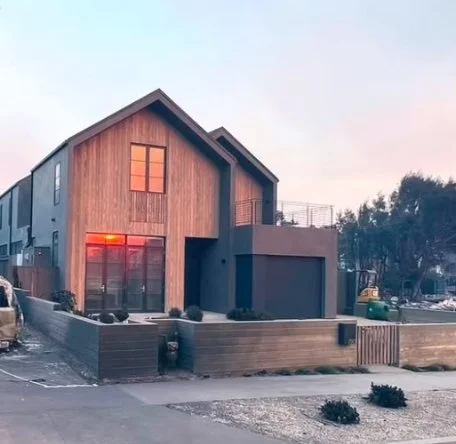The Best Fire-Resistant Materials for Rebuilding Your Home
The Lone Survivor In The Neighborhood…
This purpose designed house in the Palisades survived the fires virtually unscathed because of many of its design elements like its metal roof, tempered glass windows and concrete walls.
Building Homes That Last: The Future of Fire-Resistant Design
With wildfires becoming an increasing threat across California, homeowners looking to rebuild or renovate must think beyond aesthetics. Choosing fire-resistant materials is one of the smartest ways to protect your home while ensuring long-term durability and insurability.
Take, for example, a home in Pacific Palisades, which survived a major wildfire while neighboring properties were destroyed. The design and material choices—including a non-combustible facade, reinforced windows, and fire-rated construction—made all the difference. This underscores an essential truth: resilient design isn’t just about surviving a fire—it’s about future-proofing your home.
While I haven’t yet worked on a full fire-resistant build, I am committed to integrating these materials and strategies into future projects. The right choices not only enhance safety and sustainability but also ensure that insurance companies view your home as a lower risk, making coverage more accessible and affordable.
Here’s what you need to know about the best fire-resistant materials for your home—inside and out.
Best Fire-Resistant Materials for Home Exteriors
1. Exterior Walls & Siding
Your home’s outer shell is the first line of defense against wildfires.
✔ Magnesium Oxide (MgO) Boards – A cutting-edge alternative to drywall, MgO panels are fireproof, mold-resistant, and incredibly durable.
✔ Fiber Cement Siding – A mix of cement, sand, and cellulose fibers, this non-combustible material mimics wood while being far more fire-resistant.
✔ Stucco – A thick cement-based finish that, when applied correctly, adds a significant fire-resistant barrier.
✔ Brick & Stone – Naturally non-combustible, these materials help prevent flame spread.
2. Roofing Materials
Roofing is one of the most vulnerable areas in a wildfire, as embers can land and ignite flammable materials.
✔ Metal Roofing – Highly fire-resistant and durable, metal roofs are an excellent long-term investment.
✔ Clay or Concrete Tiles – These don’t ignite and slow fire spread, though they may require additional structural support due to weight.
✔ Class A Asphalt Shingles – A more affordable fire-resistant option, especially when combined with fireproof underlayment.
3. Windows & Doors
Heat from a wildfire can cause standard glass to shatter, leaving interiors exposed to flames and embers.
✔ Tempered Glass Windows – Four times stronger than regular glass, making them far more resistant to heat.
✔ Fire-Rated Glass & Frames – Specifically designed to withstand extreme temperatures for longer periods.
✔ Metal or Solid-Core Doors – Unlike standard wood doors, steel and solid-core wood offer superior fire resistance.
4. Decking & Outdoor Features
Wildfires often spread through outdoor spaces before reaching the home itself.
✔ Fire-Rated Composite Decking – Brands like Trex and Fiberon use materials that resist ignition and slow flame spread.
✔ Stone or Concrete Pavers – Non-combustible and stylish, these make an excellent choice for patios and walkways.
✔ Enclosed Eaves & Vents – Prevents embers from getting trapped under overhangs and igniting a fire.
Fire-Resistant Interior Materials & Finishes
Most discussions on fire-resistant design focus on exteriors, but interior materials matter just as much.
✔ Gypsum Board (Fire-Rated Drywall) – Often required by code in fire-prone areas, this has a core made of non-combustible material that slows fire spread.
✔ Mineral Wool Insulation – Unlike traditional fiberglass, mineral wool is non-combustible and provides excellent fire resistance.
✔ Porcelain & Natural Stone Tile – For flooring, tile is one of the best fire-resistant choices, as it won’t burn or emit toxic fumes.
✔ Hardwood Over Carpet – If a fire reaches inside the home, carpet acts as fuel, while hardwood or stone flooring slows down its spread.
Beyond Materials: Smart Fire Protection Strategies
In addition to fire-resistant materials, consider integrating modern fire prevention measures into your home design:
✔ Smart Fire Detection Systems – Advanced smoke detectors and heat-sensing systems that notify homeowners instantly.
✔ Outdoor Sprinkler Systems – Installed along the home’s perimeter, these can douse embers before they ignite.
✔ Defensible Landscaping – Keeping trees, shrubs, and other vegetation at a safe distance prevents them from acting as fuel.
Future-Proofing Your Home with Fire-Resistant Design
Fire-resistant materials aren’t just about safety—they’re about longevity, sustainability, and ensuring that your home can withstand the unexpected.
As I continue to work with clients in rebuilding and renovating, I am committed to integrating these materials and design strategies into future projects. The goal? Homes that are beautiful, functional, and built to last—even in fire-prone regions.
📍 Need expert guidance on your fire-resistant rebuild? Let’s discuss how we can create a home that’s both resilient and refined. Contact me today.

